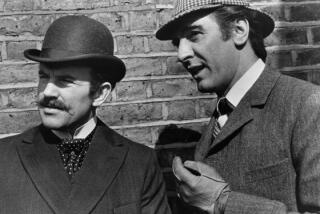A Great Inventor, or a Big Fraud
- Share via
LAS VEGAS — Jerome H. Lemelson was dying.
One of the nation’s most prolific and perhaps greatest inventors had been diagnosed with a rare stomach cancer. The disease had spread to his liver, ravaging his body and causing severe pain.
In his final days at Cedars-Sinai Medical Center in 1997, the 74-year-old Lemelson couldn’t eat or drink. Jaundiced and bedridden, he did not complain.
He made no special requests. His room was the same as any other patient’s.
Nor did he brag about his vast accomplishments. More than 600 patents to his credit. A fortune amassed. Powerful foes toppled.
He believed his place in history had been secured, thanks to his most spectacular inventions: machine vision and the bar code scanner, technology that has dramatically altered the way in which we live.
“He was a simple man,” said his Houston oncologist, Dr. Giora M. Mavligit. “A mensch.”
But to his detractors, Lemelson was something else.
They claim Lemelson’s patents were in fact worthless. Lemelson, they say, was one of the great frauds of the 20th century.
Critics charge that for decades Lemelson manipulated the U.S. Patent and Trademark Office. They accuse him of exploiting loopholes that forced 979 companies -- including Ford, Dell, Boeing, General Electric, Mitsubishi and Motorola -- to pay $1.5 billion in licensing fees.
“Anything he claims to have invented, he didn’t. He’s a science fiction writer,” said Robert Shillman, founder, chairman and chief executive at Cognex Corp., the world’s largest maker of machine vision products and one of Lemelson’s most truculent opponents.
On his deathbed, Lemelson knew he had enemies. But he thought he had defeated them, that he had built an impregnable machine to protect his inventions after his death: a for-profit foundation that would enforce his patents and collect millions in royalties.
For years, it would do just that. A team of tenacious Lemelson lawyers humbled the giants of business, protecting his name and suing any corporation they accused of using his ideas.
Lemelson was dying, but his legacy was immortal. At least that’s the way it seemed.
*
On Christmas Eve in 1954 -- the same year he married his wife, Dolly -- Lemelson filed a 150-page patent application with the U.S. Patent and Trademark Office.
The application spelled out how a robot could perform a variety of fantastic tasks during industrial production, such as riveting, welding and transport. It also showed how a robot, armed with a camera, could serve as a quality control inspector and manage jobs that the human eye could not.
Two years later, Lemelson submitted another application expanding on the previous one.
Those two applications, Lemelson said, contained the genesis of machine vision and computerized automatic identification, later known as bar code scanning -- concepts the rest of the world wouldn’t come to recognize until decades later.
Lemelson never bothered to construct a model or build a company around the designs. The patent office didn’t require it. The lone inventor didn’t have time to take his ideas from drawing board to assembly line.
He was too busy dreaming, doodling and reading technical journals that drove his prodigious imagination. A builder of gas-powered model airplanes since he was a boy, he had satiated his intellectual curiosity in the engineering department of the Army Air Corps during World War II.
He later earned two master’s degrees in aeronautical and industrial engineering at New York University, and did post-graduate work in the military’s Project Squid, which was developing jet engines. Then he worked as a safety engineer at a copper smelting company -- his last paying job, said Robert Lemelson, his son.
Instead, at his various New Jersey homes, Lemelson toiled away. Technical marvels existed everywhere. He put notion after notion onto thousands of legal pads. Nothing seemed out of reach.
“A lot of the times the ideas that Jerry came up with were practical and a lot of times they were impractical from a commercial point of view,” said his younger brother, Howard, 80, a retired electrical engineer.
Many companies rejected his ideas and over time the perceived snubs left Lemelson frustrated and bitter. Eventually, Lemelson came to see himself as a casualty of corporate greed.
But after many lean years, during which Dolly, an interior decorator, supported the family, Lemelson found success. He licensed his automatic warehousing system to a British firm in 1964 for about $100,000, plowing the money back into his inventions and legal struggles.
In the early ‘70s, he sold his audiocassette drive mechanism to Sony for $2 million. It became the basis for today’s Walkman.
IBM also bought about 20 of his patents for data and word processing systems in 1981, earning him about $5 million.
The deals not only salved Lemelson’s ego, they emboldened him. They brought an air of legitimacy to his many patents, and he wanted other companies to recognize their validity.
He wanted them to pay.
*
By 1986, Lemelson had nearly 400 patents, and litigation was his way of enforcing them. Like Thomas Edison, he regarded a patent as a right to sue; if a company developed a product that might in some way resemble one of his patents, Lemelson would take it to court.
His family pleaded with him to ease up, to take his newly found wealth and retire.
“He couldn’t just fold and let people walk all over him,” said Dolly, a petite 79-year-old woman with an unshakable belief in her husband’s genius. “... He wanted people to respect him and respect his name.”
Lemelson sought out Gerald Hosier, a maverick attorney who was quickly becoming a legend in the insulated world of patent law. Hosier gambled and took patent cases on contingency -- earning fees only if he won, an unusual arrangement given the complexities and whopping price tags that accompany such litigation.
Lemelson had been awarded a patent in 1962 (No. 3016845) for a toy and track assembly. In 1989, Hosier represented Lemelson in his lawsuit against Mattel Toys; that slender, elastic track that Hot Wheels cars zoomed along was his idea, they insisted.
Yes, the jury said. Lemelson was awarded about $71 million.
An outraged Mattel appealed to the U.S. Court of Appeals for the Federal Circuit. Still, Mattel was willing to pay to end the nasty dispute, offering to settle for more than $20 million.
To everybody’s disbelief, Lemelson rejected the offer.
“He felt so strongly that he had been wronged,” said his son, Eric, a winemaker outside of Portland, Ore.
In June 1992, the appeals court issued a 3-0 decision in Mattel’s favor, and the jury award -- which had ballooned to more than $80 million with post-judgment interest -- vanished.
Lemelson and Hosier walked away with nothing.
The pair were negotiating with Sony on a series of patents at the Grand Hyatt in San Francisco when word reached them.
Hosier crunched the bitter numbers. “I wasn’t exactly thrilled,” he said. Lemelson took it harder. He cried.
*
The U.S. Patent and Trademark Office in Alexandria, Va., is home to the more than 6.7 million patents that have been granted since 1790, when the first patent was issued for a method of making potash fertilizer.
Inside four buildings spanning 2 million square feet, approximately 3,753 patent examiners and 286 trademark attorneys handle the onerous work of vetting the applications, deciding whether an inventor’s discovery entitles them to exclusive rights to it.
This is the bureaucracy that Lemelson faced when he submitted two applications in 1954 and 1956 that he considered the basis of machine-vision technology and bar code scanners. The applications ground their way through the patent process until 1963, when a patent with the title “automatic measurement apparatus” was issued.
Appeals, continuations and more applications broadened his license of ownership over time.
This maneuvering allowed Lemelson to capture emerging technology that was entering the market, said Bruce A. Lehman, who was U.S. patent commissioner from 1993 to 1998.
Patents were designed to give inventors the opportunity to raise capital and start businesses, Lehman said. At the time, a patent was supposed to be a 17-year contract with society; the inventor benefits during that span, and then his work can be used freely by society.
Lehman said Lemelson abused the system.
“The purpose of the patent system isn’t to sit there in the weeds and let someone else go out and do all the work and sue them,” he said. “That’s not the way the patent system is supposed to work.”
But the system worked for Lemelson, especially after the Process Patent Amendments Act was enacted in 1988, declaring that a foreign company could no longer infringe on a patent without consequences, which included damages and a ban on U.S. sales.
The significance of the new law was not lost on Lemelson’s shrewd patent lawyer. He capitalized quickly.
“You have to understand how lucky they were. That saved his butt. That meant he could sue the Japanese,” said professor Martin J. Adelman, who testified in the Mattel trial and directs the Dean Dinwoodey Center for Intellectual Property Studies at George Washington University.
Lemelson believed Toyota, Nissan, Honda and Mazda, among others, were infringing on his machine-vision patents. If Hosier asserted the Lemelson patents, he might stop them from exporting their cars to the United States.
The Japanese couldn’t let the case go to trial.
They signed a settlement worth about $100 million.
“You weigh your risks,” said Frederick Michaud, a patent lawyer who represented Japanese automakers. “That is the difficulty with all patent litigation. How much is it going to cost to get out of it?”
*
Next week: Lemelson targets Ford, GM and Chrysler.
More to Read
Inside the business of entertainment
The Wide Shot brings you news, analysis and insights on everything from streaming wars to production — and what it all means for the future.
You may occasionally receive promotional content from the Los Angeles Times.










